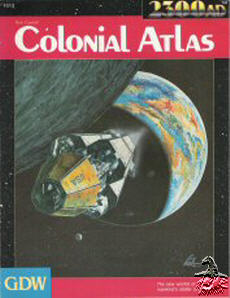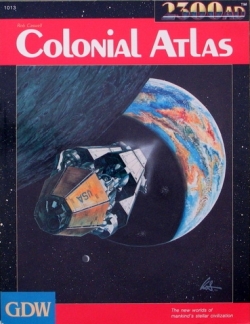Colonial Atlas
 |
 |
Every one of Earths 29 colony worlds is described in Colonial Atlas¸ with information on each of the following:
SYSTEM DATA: The colony worlds are¸ for the most part¸ nestled upon the cream of explored planets. But the rest of the worlds within a starsystem can have a great impact upon the colony and may even have been the original impetus for human settlement. This section describes the primary or primaries of the system and its family of planetary bodies¸ some of which are quite valuable to the human effort in distant space.
PLANETARY DATA: Every planet has its own unique character. Some planets are tectonically active¸ while others are more stable¸ or are manipulated by nearby gravity wells or recent meteor impacts. Nearly all the colony worlds have their own biosphere¸ evolved individually on the worlds to create a variety of life forms¸ most of which are still barely understood. From the great silted seas of Botany Bay to the Eber ruins of Beta Hydri¸ each of Earths colony worlds offers a wealth of unique characteristics for exploration and adventure.
COLONIAL DATA: Man has travelled to the stars and settled the more hospitable planets but failed to leave balkanization behind. More than a dozen of Earths nations have established off-world colonies¸ many sharing planets under the protection of the Melbourne Accords. Some generalizations apply¸ as exemplified by the names given to the three arms of human space¸ but virtually every nation on Earth is now represented throughout mans stellar community.
Colonial maps and system charts are available online.
The Tirane Sourcebook lavishly details the New Earth at Alpha Centauri.
Since the first colonies were placed on Tirane in the mid-2100s¸ the human prsence in spac has expanded widly. With each new garden world discovered¸ the nations of Earth scramble to place their power base in the stellar civilization.
Every one of Earth's 29 colony worlds is described in Colonial Atlas¸ wih information on wach of the following:
System Data: The colony worlds are¸ for the most part¸ nestled upon the cream of explored planets. But the rest of the wrlds within a star system can have a great impact upon the colny and may even have been the original impetus for human settlement. This section describes the primary or primaries of the system¸ and its family of planetery bodies¸ some of which are quite valuable to the human effort in distant soace.
Plantary Data: Every planet has its own unique charater. Some planets are tectonically active¸ while others are more stable¸ or are manipulated by nearby gavity wells or recent meteor impacts. Nearly all the colony worlds have their own biosphere¸ evolved individually on the worlds to create a variety of life forms¸ most of which are still barely understood. Form the great silted seas of Botany Bay to the Eber ruins of Beta Hydri¸ each of Earth's colory worlds offers a wealth of unique characteristics for exploration and adventure.
Colonial Data: Man has travelled to the stars and settled the more hospitable planets but failed to leave balkanization behind. More than a dozen of Earth's nations have established off-world colonies¸ many sharing planets under the protection of the Melbourne Accords. Some generalizations apply¸ as exemplified by the names given to the three arms of human space¸ but virtually every nation on Earth is now represented throughout man's stellar community.
Every one of Earth's 29 colony worlds is described¸ with system¸ planetary¸ and colonial data.Since the first colonies were placed on Tirane in the mid-2100s¸ the human prsence in spac has expanded widly. With each new garden world discovered¸ the nations of Earth scramble to place their power base in the stellar civil
Since the first colonies were placed on Tirane in the mid-2100s¸ the human prsence in spac has expanded widly. With each new garden world discovered¸ the nations of Earth scramble to place their power base in the stellar civilization. Every one of Earth's 29 colony worlds is described in Colonial Atlas¸ wih information on each of the following:
- System Data: The colony worlds are¸ for the most part¸ nestled upon the cream of explored planets. But the rest of the wrlds within a star system can have a great impact upon the colny and may even have been the original impetus for human settlement. This section describes the primary or primaries of the system¸ and its family of planetery bodies¸ some of which are quite valuable to the human effort in distant space.
- Plantary Data: Every planet has its own unique charater. Some planets are tectonically active¸ while others are more stable¸ or are manipulated by nearby gavity wells or recent meteor impacts. Nearly all the colony worlds have their own biosphere¸ evolved individually on the worlds to create a variety of life forms¸ most of which are still barely understood. Form the great silted seas of Botany Bay to the Eber ruins of Beta Hydri¸ each of Earth's colory worlds offers a wealth of unique characteristics for exploration and adventure.
- Colonial Data: Man has travelled to the stars and settled the more hospitable planets but failed to leave balkanization behind. More than a dozen of Earth's nations have established off-world colonies¸ many sharing planets under the protection of the Melbourne Accords. Some generalizations apply¸ as exemplified by the names given to the three arms of human space¸ but virtually every nation on Earth is now represented throughout man's stellar community.